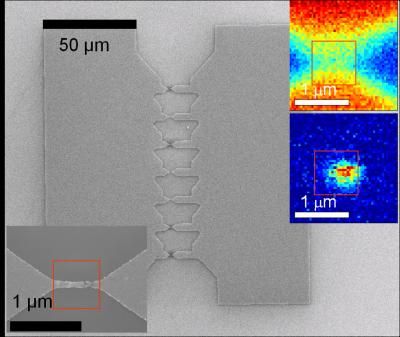Rice scientists make breakthrough in single-molecule sensing
Simultaneous optical and electronic measurements on same molecule
Advertisement
In a study that could lay the foundation for mass-produced single-molecule sensors, physicists and engineers at rice University have demonstrated a means of simultaneously making optical and electronic measurements of the same molecule. The research is slated to appear in Nano Letters. The experiments were performed on a nanoelectronic device consisting to two tiny electrodes separated by a molecule-sized gap. Using electric current, the researchers measured conduction through single molecules in the gap. In addition, light-focusing properties of the electrodes allowed the researchers to identify the molecule by a unique optical fingerprint.

Rice University scientists use tiny gaps between gold electrodes to simultaneously perform electronic and optical measurements of the same molecule. These scanning electron images show electrodes and gaps on a silicon chip. The color insets show optical signals due to the chip (top) and a gap (bottom).
D. Natelson/Rice University
"We can mass-produce these in known locations, and they have single-molecule sensitivity at room temperature in open air," said study co-author Douglas Natelson, associate professor of physics and astronomy and co-director of Rice's Quantum Magnetism Laboratory (QML). "In principle, we think the design may allow us to observe chemical reactions at the single-molecule level."
While scientists have used electronic and optical instruments to measure single molecules before, Rice's system is the first that allows both simultaneously - a process known as "multimodal" sensing - on a single small molecule.
The research sprang from a collaboration between Natelson's group - where the electrodes were developed - and Rice's Laboratory for Nanophotonics (LANP), where the simultaneous electronic and optical testing was performed. In research published last year, the two groups explained how the electrodes focus near-infrared light into the molecule-sized gap, increasing light intensity in the gap by as much as a million times. The increased intensity allows the team to collect unique optical signatures for molecules trapped there via a technique called surface enhanced Raman spectroscopy (SERS).
"Our latest results confirm that we have the sensitivity required to measure single molecules," said LANP Director Naomi Halas, the Stanley C. Moore Professor of Electrical and Computer Engineering and professor of chemistry. "That sensitivity, and the multimodal capabilities of this system, gives us a great tool for fundamental science at the nanoscale."
Daniel Ward, a student in Natelson's research group, built the electrodes from tiny gold wires on silicon wafers and performed the critical measurements. The group specializes in studying the electronic and magnetic properties of nanoscale objects - particles and devices that are built with atomic precision. The devices are so small they can only be seen with certain types of microscopes, and even those provide unclear pictures at best. Natelson said the new multimodal device gives researchers a much clearer idea of what is going on by combining two different kinds of measurements, electronic and optical.
"Conduction across our electrodes is known to depend on a quantum effect called 'tunneling,'" Natelson said. "The gaps are so small that only one or two molecules contribute to the conduction. So when we get conduction, and we see the optical fingerprint associated with a particular molecule, and they track each other, then we know we're measuring a single molecule and we know what kind of molecule it is. We can even tell when it rotates and changes position."
































































